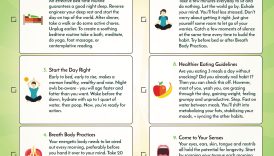Simplify Your Life with These Easy Healthy Living Strategies

In today’s fast-paced world, maintaining a healthy lifestyle may seem like a daunting task. The constant juggle between work, family, and social obligations often leaves little room for self-care. However, the foundation of well-being primarily rests on four main pillars: a balanced diet, regular physical activity, quality sleep, and effective stress management. Understanding how these elements interconnect can empower individuals to foster a healthier life.
- Simplify Your Life with These Easy Healthy Living Strategies
- The Importance of a Holistic Approach
- Establishing a Balanced Diet
- Importance of Nutrient-Rich Foods
- Meal Planning Tips
- Prioritizing Physical Activity
- Benefits of Regular Exercise
- Simple Ways to Stay Active Daily
- Quality Sleep for Overall Well-being
- Understanding Sleep Cycles
- Creating a Relaxing Bedtime Routine
- Stress Management Techniques
- Mindfulness Practices
- Effective Time Management Strategies
The Importance of a Holistic Approach
Adopting a holistic approach to health not only simplifies the process but also enhances the overall effectiveness of these lifestyle changes. Think about how they work together:
- Nourishment fuels activity: The foods consumed provide the essential nutrients that energize the body for exercise.
- Exercise enhances sleep quality: Regular movement helps regulate sleep patterns, making it easier to achieve restorative rest.
- Sleep improves focus and reduces stress: A good night’s sleep sharpens mental clarity and helps in handling daily pressures with grace.
- Balanced lifestyle fosters happiness: Incorporating these practices leads to a more fulfilling and joyful life.
In many ways, these four pillars serve as a compass guiding individuals towards their desired health goals. One personal story worth sharing involves a friend who felt persistently fatigued through busy work weeks. After a dedicated effort to revamp her daily habits—enriching her diet with nutrient-dense foods, committing to a workout routine, and prioritizing sleep—she noticed a transformation in her energy levels and overall outlook. This kind of experience is not unique; many have found that when they make small changes to their daily routines, the benefits amplify across various aspects of their lives. As we delve deeper into each of these pillars, readers will discover practical tips and strategies to incorporate them into their lives seamlessly. After all, incorporating these foundational elements is not just about immediate results; it’s about creating a sustainable lifestyle that fosters long-term well-being.
Establishing a Balanced Diet
Having laid the groundwork for a healthier lifestyle, the next step is establishing a balanced diet. This crucial element not only supports the body’s day-to-day functions but also fuels physical activity and enhances mental clarity.
Importance of Nutrient-Rich Foods
Nutrient-rich foods are the cornerstone of a balanced diet. These foods provide the essential vitamins, minerals, and macronutrients necessary for optimal health. Incorporating them into daily meals can lead to improved energy levels, better mood, and enhanced concentration. Consider the following benefits of a diet rich in nutrients:
- Boosted Immune System: Foods high in antioxidants, such as berries and leafy greens, help combat inflammation and protect against disease.
- Weight Management: Nutrient-dense foods, like whole grains and proteins, help keep you full longer, reducing the tendency to snack on less healthy options.
- Improved Digestion: Incorporating fiber from fruits, vegetables, and legumes contributes to a healthy digestive system.
One personal experience to highlight is a time when a colleague decided to swap out processed snacks for fruits and nuts during the workday. Not only did she report feeling more energized, but she also noticed fewer cravings for sugary options. This small dietary shift made a significant difference in her productivity!
Meal Planning Tips
To make healthy eating manageable, meal planning is a valuable strategy. It helps streamline grocery shopping and ensures that nutrient-rich foods are readily available during the week. Here are some practical meal planning tips:
- Set Aside Time Weekly: Dedicate a day to plan meals and create a grocery list based on your choices.
- Balance Your Plate: Aim for a variety of food groups—think half your plate with vegetables, a quarter with lean protein, and a quarter with whole grains.
- Prepare Ahead: Cook larger batches of healthy recipes and store leftovers in portioned containers for easy access.
- Mix It Up: Experiment with a wide range of ingredients to keep meals exciting.
By incorporating these meal planning tips and focusing on nutrient-rich foods, individuals can create a solid foundation for a balanced diet, paving the way for sustainable health improvements. The journey toward a healthier lifestyle is not a sprint but a gradual transition that can lead to transformative changes over time.
Prioritizing Physical Activity
While establishing a balanced diet lays the groundwork for health, prioritizing physical activity is essential to maximize its benefits. Regular exercise not only complements good nutrition but also plays a pivotal role in enhancing overall well-being.
Benefits of Regular Exercise
The positive effects of incorporating physical activity into daily life are well-documented and far-reaching. Here are some key benefits:
- Physical Health: Regular exercise strengthens the heart, improves circulation, and helps maintain a healthy weight. It also reduces the risk of chronic diseases such as type 2 diabetes and hypertension.
- Mental Clarity: Engaging in physical activity releases endorphins, often referred to as “feel-good” hormones. This can lead to reduced stress, anxiety, and depression—promoting a more positive outlook on life.
- Increased Energy: Sounds counterintuitive, doesn’t it? However, regular movement enriches muscle and cardiovascular health, ultimately resulting in higher energy levels.
- Enhanced Sleep Quality: Exercising consistently can help regulate sleep patterns, allowing for deeper, more refreshing rest.
My friend Mark found that a brisk walk during his lunch break revitalized his focus for the rest of the day. The simple act of stepping outside acted as both a physical and mental reset, leading to improved productivity.
Simple Ways to Stay Active Daily
Incorporating physical activity into daily life doesn’t have to be overwhelming. Here are some simple strategies that can seamlessly fit into a busy schedule:
- Take the Stairs: Opt for stairs instead of elevators whenever possible. It’s an excellent way to get the heart pumping.
- Walking Meetings: If possible, suggest walking meetings with colleagues. This encourages movement and fosters a fresh atmosphere for discussion.
- Set a Timer: Every hour, take a few minutes to stretch or walk around your workspace. Even short bursts of activity can accumulate significant benefits.
- Join a Class: Whether it’s yoga, dance, or spinning, group classes are a fun way to stay motivated and meet new people.
- Engage in Family Activities: Plan outdoor family excursions, such as hiking, biking, or playing sports, to create lasting memories while being active.
By prioritizing physical activity through these simple approaches, individuals can enhance their health and well-being. It’s evident that movement is not just a chore; it can be woven into the fabric of daily routines, making this journey to better health both enjoyable and sustainable.
Quality Sleep for Overall Well-being
Having discussed the significance of physical activity, it’s time to shine a light on another vital aspect of health—quality sleep. While many may underestimate the power of a good night’s rest, its role in overall well-being is monumental. Quality sleep enables the body to recover and rejuvenate, impacting everything from mood to cognitive function.
Understanding Sleep Cycles
To appreciate the importance of quality sleep, it helps to understand how sleep cycles work. Sleep consists of several cycles, each lasting roughly 90 minutes and composed of various stages:
- NREM Stage 1: The lightest sleep phase where you drift in and out of sleep.
- NREM Stage 2: A deeper sleep where your body temperature drops and heart rate slows.
- NREM Stage 3: Often referred to as deep sleep, this is when the body repairs tissue and builds bone and muscle.
- REM Sleep: This stage is crucial for processing memories and fostering creativity. It’s characterized by rapid eye movement and vivid dreaming.
My sister once struggled with fatigue despite spending ample hours in bed. After learning about sleep cycles, she realized the importance of not only the duration but also the quality of her sleep. By aligning her bedtime routine to allow for uninterrupted cycles, she significantly reduced her grogginess in the mornings.
Creating a Relaxing Bedtime Routine
Establishing a calming bedtime routine can greatly enhance sleep quality. Here are some effective strategies to incorporate before hitting the hay:
- Set a Consistent Sleep Schedule: Go to bed and wake up at the same time every day, even on weekends, to regulate your body’s internal clock.
- Limit Screen Time: Reduce exposure to screens at least an hour before bed. The blue light emitted can interfere with melatonin production and disrupt sleep cycles.
- Create a Sleep-Inducing Atmosphere: Make your bedroom a sanctuary for sleep. This can include dimming the lights, keeping the room cool, and using blackout curtains.
- Engage in Relaxation Techniques: Activities such as reading, meditating, or taking a warm bath can signal to your body that it’s time to unwind.
- Avoid Stimulants: Steer clear of caffeine and heavy meals close to bedtime to ensure your body is ready for rest.
Integrating these practices into a nightly routine can lead to deeper sleep and, ultimately, improved overall health. Quality sleep isn’t just a luxury; it’s a necessity that supports physical and mental rejuvenation, making it an essential pillar in the quest for a healthier lifestyle.
Stress Management Techniques
As we explore the final pillar of a healthy lifestyle, it becomes clear that managing stress effectively is crucial for maintaining both mental and physical well-being. Life’s demands can often feel overwhelming, but implementing stress management techniques can help regain a sense of control. Two powerful approaches to consider are mindfulness practices and effective time management strategies.
Mindfulness Practices
Mindfulness is the art of staying present and fully engaging with the current moment. This practice can significantly reduce stress and enhance emotional resilience. Here are some simple mindfulness techniques anyone can adopt:
- Meditation: Even a few minutes of meditation each day can lead to profound changes in emotional well-being. Apps like Headspace or Calm offer guided sessions for beginners.
- Deep Breathing: When feeling overwhelmed, take a moment to focus on your breath. Practice inhaling deeply for four counts, holding for four, and exhaling for four. This simple exercise can help ground you.
- Mindful Walking: During a walk, concentrate on the sensations of your feet connecting with the ground and the rhythm of your breath. This practice connects the body and mind and can be refreshing.
A personal anecdote comes to mind: A colleague of mine, overwhelmed with work assignments, began implementing a 5-minute mindfulness break each hour. She shared that these short breaks allowed her to reset and approach her tasks with greater clarity and creativity.
Effective Time Management Strategies
Another way to combat stress is through effective time management. When life becomes busy, learning to prioritize tasks can alleviate feelings of chaos. Here are some practical strategies for better time management:
- Create a To-Do List: Each morning, jot down the day’s priorities. Focus on three main tasks to accomplish for clarity.
- Set Realistic Deadlines: Assign deadlines not just for tasks but also for breaks to prevent burnout. Remember, pace matters!
- Use the Pomodoro Technique: Work for 25 minutes, then take a 5-minute break. This structured approach helps maintain focus and productivity.
- Learn to Say No: It’s crucial to recognize your limits. Saying no to additional commitments can protect your time and help manage stress levels.
By incorporating both mindfulness practices and effective time management strategies, individuals can navigate life’s challenges with greater ease. Remember, stress is an inevitable part of life, but how one chooses to manage it makes all the difference. Embracing these techniques can lead to a more balanced, fulfilling existence where health and well-being truly flourish.





